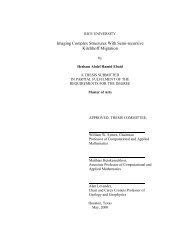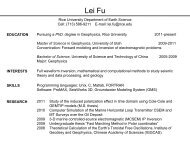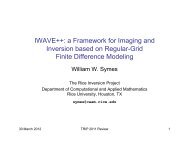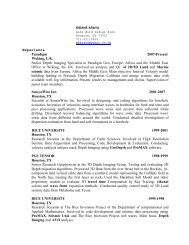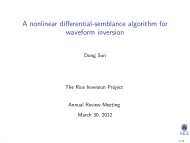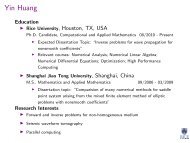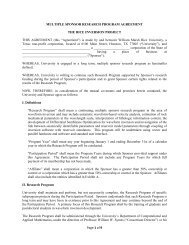Seismic Inversion - The Rice Inversion Project - Rice University
Seismic Inversion - The Rice Inversion Project - Rice University
Seismic Inversion - The Rice Inversion Project - Rice University
Create successful ePaper yourself
Turn your PDF publications into a flip-book with our unique Google optimized e-Paper software.
university-logo<br />
Model Extensions and Inverse Scattering:<br />
<strong>Inversion</strong> for <strong>Seismic</strong> Velocities<br />
William W. Symes ⋆<br />
⋆ <strong>Rice</strong> <strong>University</strong><br />
October 2007<br />
William W. Symes ⋆ ( ⋆ <strong>Rice</strong> <strong>University</strong>) Model Extensions and Inverse Scattering: <strong>Inversion</strong> for <strong>Seismic</strong> Velocities 24-09-2007 1 / 24
university-logo<br />
Expanded version of presentation in “Recent Advances and Road Ahead”<br />
session, SEG 2007.<br />
References to related SEG 07 talks in red - available via Scitation,<br />
www.seg.org.<br />
PDF available at www.trip.caam.rice.edu.<br />
Draft paper with references: www.caam.rice.edu, TR 07-05.<br />
William W. Symes ⋆ ( ⋆ <strong>Rice</strong> <strong>University</strong>) Model Extensions and Inverse Scattering: <strong>Inversion</strong> for <strong>Seismic</strong> Velocities 24-09-2007 2 / 24
Introduction<br />
Focus: recent developments in waveform inversion (WI) for velocity, and<br />
relation to migration velocity analysis (MVA).<br />
Main topics:<br />
Why inversion via least squares data fitting (“waveform inversion”)<br />
doesn’t work for exploration seismology;<br />
How migration is an approximate solution of the linearized inverse<br />
problem;<br />
How “Kirchhoff” and “Wave Equation” prestack depth migration<br />
differ, and what that means for migration velocity analysis;<br />
How to formulate migration velocity analysis via optimization, use all<br />
events;<br />
How to view migration velocity analysis as a solution of a “partly<br />
linear” waveform inversion problem;<br />
How nonlinear waveform inversion might be integrated with migration<br />
velocity analysis.<br />
university-logo<br />
William W. Symes ⋆ ( ⋆ <strong>Rice</strong> <strong>University</strong>) Model Extensions and Inverse Scattering: <strong>Inversion</strong> for <strong>Seismic</strong> Velocities 24-09-2007 3 / 24
Marine <strong>Seismic</strong> Reflection Experiment<br />
Airguns = source of sound. Streamer consists of hydrophone receiver<br />
groups. Each group records a trace (time series of pressure) for each shot<br />
= excitation of source. Source-receiver distance = offset.<br />
university-logo<br />
William W. Symes ⋆ ( ⋆ <strong>Rice</strong> <strong>University</strong>) Model Extensions and Inverse Scattering: <strong>Inversion</strong> for <strong>Seismic</strong> Velocities 24-09-2007 4 / 24
university-logo<br />
Typical Shot Record<br />
time (s)<br />
0<br />
0.5<br />
1.0<br />
1.5<br />
2.0<br />
offset (km)<br />
0.5 1.0 1.5<br />
CMP gather from North Sea Survey<br />
(thanks: Shell).<br />
Processing applied:<br />
bandpass filter 3-8-25-35 Hz;<br />
cutoff or mute to remove<br />
non-reflection energy (direct,<br />
diving, head waves);<br />
predictive deconvolution to<br />
suppress multiple reflections.<br />
William W. Symes ⋆ ( ⋆ <strong>Rice</strong> <strong>University</strong>) Model Extensions and Inverse Scattering: <strong>Inversion</strong> for <strong>Seismic</strong> Velocities 24-09-2007 5 / 24
Mechanical properties of sedimentary rocks<br />
v p varies significantly.<br />
Heterogeneity at all scales - km<br />
to mm to µm.<br />
Well (v p) log from Texas borehole<br />
(thanks: P. Janak, Total E&P, USA)<br />
university-logo<br />
William W. Symes ⋆ ( ⋆ <strong>Rice</strong> <strong>University</strong>) Model Extensions and Inverse Scattering: <strong>Inversion</strong> for <strong>Seismic</strong> Velocities 24-09-2007 6 / 24
Point Source Acoustics - the minimal model<br />
Earth = Ω = R 3 . Wave equation for acoustic potential response to<br />
isotropic point radiator at x s , time dependence w(t):<br />
( 1<br />
v 2 ∂ 2 u<br />
∂t 2 − ∇2 )<br />
u(t, x; x s ) = w(t)δ(x − x s )<br />
plus initial and boundary conditions.<br />
Lions, late ’60’s: problem well posed for v ∈ A 0 = {log v ∈ L ∞ (Ω)}, RHS<br />
in L 2 ([0, T ] × Ω).<br />
Forward map: F : A 0 → L 2 (Σ × [0, T ]), Σ ⊂ {x 3 = 0} × {x 3 = 0} open,<br />
samples pressure:<br />
(<br />
F[v](t, x r ; x s ) = φ ∂u )<br />
(t, x r ; x s ), (t, x r , x s ) ∈ [0, T ] × Σ, φ ∈ C0<br />
∞ (Σ)<br />
∂t<br />
If v = v 0 known & constant in {x 3 < z} for some z > 0, slight extension<br />
of Lions shows F well-defined. Stolk 2000: continuous, diffb’le<br />
“with loss of derivative”.<br />
university-logo<br />
William W. Symes ⋆ ( ⋆ <strong>Rice</strong> <strong>University</strong>) Model Extensions and Inverse Scattering: <strong>Inversion</strong> for <strong>Seismic</strong> Velocities 24-09-2007 7 / 24
university-logo<br />
Agenda<br />
1 Waveform <strong>Inversion</strong><br />
2 Migration Velocity Analysis<br />
3 Semblance and Optimization<br />
4 Extended Modeling: MVA + WI<br />
5 Conclusions and Prospects<br />
William W. Symes ⋆ ( ⋆ <strong>Rice</strong> <strong>University</strong>) Model Extensions and Inverse Scattering: <strong>Inversion</strong> for <strong>Seismic</strong> Velocities 24-09-2007 8 / 24
<strong>Inversion</strong> Generalities<br />
<strong>The</strong> usual set-up:<br />
M = a set of models (v ∈ A 0 );<br />
D = a Hilbert space of (potential) data (L 2 ([0, T ] × Σ));<br />
F : M → D: modeling operator or “forward map”.<br />
Waveform inversion problem: given d ∈ D, find v ∈ M so that F[v] ≃ d.<br />
F can incorporate any physics - acoustics, elasticity, anisotropy,<br />
attenuation,.... (and v may be more than velocity...).<br />
Typical problem size for adequately sampled 3D survey simulation:<br />
dim(M) ∼ 10 10 , dim(D) ∼ 10 12<br />
⇒ any computational “solution” must admit algorithms that scale well<br />
with problem size - if iterative, then iteration count should be essentially<br />
independent of dimension.<br />
university-logo<br />
William W. Symes ⋆ ( ⋆ <strong>Rice</strong> <strong>University</strong>) Model Extensions and Inverse Scattering: <strong>Inversion</strong> for <strong>Seismic</strong> Velocities 24-09-2007 9 / 24
Output Least Squares <strong>Inversion</strong><br />
Given d ∈ D, find v ∈ M to minimize<br />
J OLS (v, d) = 1 2 ‖d − F[v]‖2 ≡ 1 2 (d − F[v])T (d − F[v])<br />
Has long and productive history in geophysics - but not in reflection<br />
seismology.<br />
Only Newton and relatives scale well - but these find only local minima.<br />
Unfortunately, J OLS has lots of local minima having nothing to do with<br />
“truth”, for typical length, time, and frequency scales of exploration<br />
seismology.<br />
⇒ least squares waveform inversion with Newton-like iteration “doesn’t<br />
work” (Gauthier 86, Kolb 86, Santosa & S. 89, Bunks 95, Shin 01, Shin<br />
and Min 06, many others - see Chung SI 2.4).<br />
university-logo<br />
William W. Symes ⋆ ( ⋆ <strong>Rice</strong> <strong>University</strong>) Model Extensions and Inverse Scattering: <strong>Inversion</strong> for <strong>Seismic</strong> Velocities 24-09-2007 10 / 24
university-logo<br />
Output Least Squares <strong>Inversion</strong><br />
Simple but instructive example: 1D reflection, v = v(z), wavefield is plane<br />
wave at normal incidence with wavelet w(t).<br />
At constant velocity v(z) ≡ v 0 ,<br />
where ˇw(t) = w(−t).<br />
∇J OLS [v 0 ](z) = const.<br />
( d ˇw<br />
dt ∗ (d − w) ) ( 2z<br />
v 0<br />
)<br />
If data (hence w) contains no energy at frequencies below f min , then<br />
gradient contains no energy at spatial wavelengths longer than v 0 /(2f min )<br />
⇒ first step of Newton does not even begin to reconstruct nonzero mean<br />
deviations if z d > v 0 /(4f min ).<br />
William W. Symes ⋆ ( ⋆ <strong>Rice</strong> <strong>University</strong>) Model Extensions and Inverse Scattering: <strong>Inversion</strong> for <strong>Seismic</strong> Velocities 24-09-2007 10 / 24
Output Least Squares <strong>Inversion</strong><br />
Upgrade to layered (or near-layered) media via plane wave expansion,<br />
range of incidence angles θ: v 0 → v 0 / cos θ.<br />
⇒ using reflection data with incidence angles ≤ 60 ◦ , gradient-based<br />
method cannot update mean velocity over depth interval [0, z d ] if<br />
f min > v 0<br />
2z d<br />
Typical shallow sediment imaging: v 0 ≃3 km/s, z d = 5 km ⇒ to recover<br />
nonzero mean deviation from 3 km/s must have significant energy at<br />
f min ≃ 0.3Hz (cf. Bunks 95, Chung SI 2.4, Pillet SI 4.5)<br />
If not present (energetics - Ziolkowski 93) and/or filtered from data, and if<br />
〈v〉 ≠ v 0 , then spurious minima must exist (and will be found by<br />
gradient-based optimization from v init = v 0 )!<br />
university-logo<br />
William W. Symes ⋆ ( ⋆ <strong>Rice</strong> <strong>University</strong>) Model Extensions and Inverse Scattering: <strong>Inversion</strong> for <strong>Seismic</strong> Velocities 24-09-2007 10 / 24
Output Least Squares <strong>Inversion</strong><br />
0<br />
midpoint (km)<br />
0 5 10<br />
0<br />
offset (km)<br />
0 0.1 0.2 0.3 0.4 0.5<br />
v (km/s)<br />
1.0 1.5 2.0 2.5 3.0<br />
0<br />
0.1<br />
0.1<br />
0.2<br />
depth (km)<br />
0.2<br />
0.3<br />
time (s)<br />
0.2<br />
0.3<br />
0.4<br />
depth (km)<br />
0.4<br />
0.6<br />
0.4<br />
0.5<br />
0.5<br />
0.6<br />
0.8<br />
0.6<br />
0.7<br />
1.0<br />
1.6 1.8 2.0 2.2 2.4<br />
km/s<br />
Left: Layered model. Middle: response to point source in center,<br />
4-10-30-40 Hz bandpass wavelet. Right: OLS inversions, dashed=initial,<br />
solid=final. Quasi-Newton iteration terminated when gradient reduced by<br />
10 −2 .<br />
university-logo<br />
William W. Symes ⋆ ( ⋆ <strong>Rice</strong> <strong>University</strong>) Model Extensions and Inverse Scattering: <strong>Inversion</strong> for <strong>Seismic</strong> Velocities 24-09-2007 10 / 24
Output Least Squares <strong>Inversion</strong><br />
Examples of successful waveform inversion from synthetic data containing<br />
very low frequencies (
university-logo<br />
Agenda<br />
1 Waveform <strong>Inversion</strong><br />
2 Migration Velocity Analysis<br />
3 Semblance and Optimization<br />
4 Extended Modeling: MVA + WI<br />
5 Conclusions and Prospects<br />
William W. Symes ⋆ ( ⋆ <strong>Rice</strong> <strong>University</strong>) Model Extensions and Inverse Scattering: <strong>Inversion</strong> for <strong>Seismic</strong> Velocities 24-09-2007 11 / 24
university-logo<br />
<strong>The</strong> Seismologist’s Standard Model<br />
[Thanks: P. Lailly]. Because (1) F is hard to understand, (2) it’s a lot<br />
simpler, and (3) it works sometimes, assume separation of scales: v [and<br />
other mechanical parameters] superposition of:<br />
smooth macromodel v: the long-scale component of velocity etc.<br />
(scales ≃ 1 km and larger).<br />
oscillatory perturbation δv: high-frequency component of the velocity,<br />
scale ≃ 10’s of m (wavelength).<br />
( 1 ∂ 2 )<br />
u<br />
v 2 ∂t 2 − ∇2 δu(t, x; x s ) = 2δv(x) ∂ 2 u<br />
v 3 (x) ∂t 2 (t, x; x s), DF[v]δv = ∂δu<br />
∣<br />
∂t<br />
∣<br />
[0,T ]×Σ<br />
William W. Symes ⋆ ( ⋆ <strong>Rice</strong> <strong>University</strong>) Model Extensions and Inverse Scattering: <strong>Inversion</strong> for <strong>Seismic</strong> Velocities 24-09-2007 12 / 24
university-logo<br />
Linearized Acoustic Inverse Problem<br />
v smooth, r oscillatory (or even singular):<br />
( 1 ∂ 2 )<br />
u<br />
v 2 ∂t 2 − ∇2 δu(t, x; x s ) = 2δv(x) ∂ 2 u<br />
v 3 (x) ∂t 2 (t, x; x s), DF[v]δv = ∂δu<br />
∣<br />
∂t<br />
Admissible sets of macromodels: bounded A ⊂ C ∞ (Ω),...<br />
Beylkin 85, Bleistein 87, Rakesh 88, Burridge 89, Nolan 97, de Hoop 97,<br />
ten Kroode 98, Stolk 00: under ever-weaker conditions, DF[v] ∗ DF[v] is<br />
(microlocally) invertible pseudodifferential operator.<br />
Means: DF[v] almost unitary, DF[v] ∗ (d − F[v]) has same<br />
(near-)singularities as δv, differs by scaling (S., SI 2.2) - image of δv.<br />
DF[v] ∗ = prestack depth migration operator.<br />
∣<br />
[0,T ]×Σ<br />
William W. Symes ⋆ ( ⋆ <strong>Rice</strong> <strong>University</strong>) Model Extensions and Inverse Scattering: <strong>Inversion</strong> for <strong>Seismic</strong> Velocities 24-09-2007 13 / 24
university-logo<br />
Linearized Acoustic Inverse Problem<br />
Partially linearized inverse problem = Migration Velocity Analysis: given<br />
d ∈ D ≡ L 2 ([0, T ] × Σ), find v ∈ A, δv ∈ E ′ (Ω) so that<br />
DF[v]δv ≃ d − F[v].<br />
Least squares approach no more successful than for basic IP. Instead,<br />
industry has developed migration velocity analysis methods.<br />
Based on image volume I output by prestack depth migration - function of<br />
subsurface position x and other (redundant) parameters. Two major<br />
variants: surface-oriented and depth-oriented.<br />
Recent advance: understanding the difference.<br />
William W. Symes ⋆ ( ⋆ <strong>Rice</strong> <strong>University</strong>) Model Extensions and Inverse Scattering: <strong>Inversion</strong> for <strong>Seismic</strong> Velocities 24-09-2007 13 / 24
university-logo<br />
Migration and Imaging Conditions<br />
(I) Surface oriented: diffraction sum representation of image volume<br />
I S (x, h) = ∑ m<br />
(...)d(m, h, T [v](x, m − h) + T [v](x, m + h))<br />
where h = 0.5(x r − x s ) = half-offset, m = 0.5(x r + x s ) = midpoint,<br />
T (x, y) = one-way time from x to y. (...) = optional amplitude,<br />
antialiasing,.. Data with same h = offset bin.<br />
Relation is binwise: offset bin of image depends only on corresponding<br />
offset bin of data, hence “common offset”. Diffraction sum is only comp.<br />
feasible implementation, hence “Kirchhoff” migration.<br />
Other binwise migrations: common shot, common receiver, common<br />
scattering angle...<br />
William W. Symes ⋆ ( ⋆ <strong>Rice</strong> <strong>University</strong>) Model Extensions and Inverse Scattering: <strong>Inversion</strong> for <strong>Seismic</strong> Velocities 24-09-2007 14 / 24
university-logo<br />
Migration and Imaging Conditions<br />
(II) Depth oriented image volume: also has diffraction sum representation<br />
I D (x, H) = ∑ m<br />
∑<br />
(...)d(m, h, T [v](x − H, m − h) + T [v](x + H, m + h))<br />
h<br />
H is space shift or depth offset vector - unrelated to acquisition geometry.<br />
Note extra summation over h: every image value depends on all traces.<br />
Usual implementation via one-way WE (shot profile or DSR, Claerbout 85)<br />
or two-way RTM (Biondi-Shan 02, S. 02) (hence “wave equation”<br />
migration).<br />
Transform to scattering angle available - Prucha 99, Sava and Fomel 01.<br />
Time shift variant - Sava and Fomel 05.<br />
William W. Symes ⋆ ( ⋆ <strong>Rice</strong> <strong>University</strong>) Model Extensions and Inverse Scattering: <strong>Inversion</strong> for <strong>Seismic</strong> Velocities 24-09-2007 14 / 24
Migration and Imaging Conditions<br />
Imaging conditions: how to extract image from image volume.<br />
(I) Surface oriented: stack over offset<br />
I (x) = ∑ h<br />
I S (x, h)<br />
(II) Depth oriented: extract zero (depth) offset section<br />
I (x) = I D (x, 0)<br />
NB: <strong>The</strong>se really are the same! In both cases, I ≃ DF[v] ∗ (d − F[v])<br />
(high freq asymptotic approximation).<br />
So both variants produce same image...<br />
university-logo<br />
William W. Symes ⋆ ( ⋆ <strong>Rice</strong> <strong>University</strong>) Model Extensions and Inverse Scattering: <strong>Inversion</strong> for <strong>Seismic</strong> Velocities 24-09-2007 14 / 24
university-logo<br />
Migration and Imaging Conditions<br />
But not the same image volume!<br />
Nolan & S. 97, Stolk & S. 04, deHoop & Brandsberg-Dahl 03:<br />
multipathing (multiple rays connecting source, receiver, and image points,<br />
caustics) leads to artifacts in surface oriented image volume.<br />
Artifact = coherent event in wrong place, of strength comparable to<br />
correct events.<br />
Stolk & deHoop 01, S. 02, Stolk 05: depth-oriented image volume<br />
generally free of artifacts, even with strong multipathing.<br />
So the two types of image volume are not even kinematically equivalent!<br />
Accounts for perceived superiority of “wave equation migration”.<br />
Consequences for velociy analysis: Nolan and S. 97, Xu TOM 1.4.<br />
William W. Symes ⋆ ( ⋆ <strong>Rice</strong> <strong>University</strong>) Model Extensions and Inverse Scattering: <strong>Inversion</strong> for <strong>Seismic</strong> Velocities 24-09-2007 14 / 24
Migration and Imaging Conditions<br />
0<br />
x (km)<br />
2 4 6 8<br />
z (km)<br />
2<br />
1.0 1.5 2.0 2.5<br />
v (km/s)<br />
Velocity model after Valhall field, North Sea. Note sloping reflector at left,<br />
large low-velocity lens (modeling gas accumulation) in center. Both tend<br />
to produce multipathing. (Thanks: M. de Hoop, A. Malcolm)<br />
university-logo<br />
William W. Symes ⋆ ( ⋆ <strong>Rice</strong> <strong>University</strong>) Model Extensions and Inverse Scattering: <strong>Inversion</strong> for <strong>Seismic</strong> Velocities 24-09-2007 14 / 24
Migration and Imaging Conditions<br />
0<br />
x(km)<br />
2 4 6 8<br />
1<br />
t(s)<br />
2<br />
3<br />
4<br />
Typical shot gather over center of model, exhibiting extensive<br />
multipathing.<br />
university-logo<br />
William W. Symes ⋆ ( ⋆ <strong>Rice</strong> <strong>University</strong>) Model Extensions and Inverse Scattering: <strong>Inversion</strong> for <strong>Seismic</strong> Velocities 24-09-2007 14 / 24
Migration and Imaging Conditions<br />
0<br />
angle(deg)<br />
20 40 60<br />
angle(deg)<br />
0 20 40 60<br />
0<br />
0.5<br />
0.5<br />
z(km)<br />
1.0<br />
z(km)<br />
1.0<br />
1.5<br />
1.5<br />
2.0<br />
2.0<br />
Angle common image gathers at same horizontal position from<br />
surface-oriented (Kirchhoff) and depth-oriented (DSR) migrated image<br />
volumes. Left: ACIG from Kirchhoff migration: kinematic artifacts clearly<br />
visible. Right: ACIG from DSR migration: no artifacts!<br />
university-logo<br />
William W. Symes ⋆ ( ⋆ <strong>Rice</strong> <strong>University</strong>) Model Extensions and Inverse Scattering: <strong>Inversion</strong> for <strong>Seismic</strong> Velocities 24-09-2007 14 / 24
university-logo<br />
Agenda<br />
1 Waveform <strong>Inversion</strong><br />
2 Migration Velocity Analysis<br />
3 Semblance and Optimization<br />
4 Extended Modeling: MVA + WI<br />
5 Conclusions and Prospects<br />
William W. Symes ⋆ ( ⋆ <strong>Rice</strong> <strong>University</strong>) Model Extensions and Inverse Scattering: <strong>Inversion</strong> for <strong>Seismic</strong> Velocities 24-09-2007 15 / 24
university-logo<br />
Semblance<br />
Semblance condition - complementary to imaging condition.<br />
Expresses consistency between data, velocity model in terms of image<br />
volume.<br />
(I) Surface oriented: velocity-data consistency when I S (x, h) independent<br />
of h (at least in terms of phase), i.e. image gathers are flat.<br />
(II) Depth oriented: velocity-data consistency when I D (x, H) concentrated<br />
near H = 0, i.e. image gathers are focused [or flat, when converted to<br />
scattering angle].<br />
William W. Symes ⋆ ( ⋆ <strong>Rice</strong> <strong>University</strong>) Model Extensions and Inverse Scattering: <strong>Inversion</strong> for <strong>Seismic</strong> Velocities 24-09-2007 16 / 24
Semblance<br />
offset (km)<br />
-0.2 -0.1 0 0.1<br />
0<br />
offset (km)<br />
-0.2 -0.1 0 0.1<br />
0<br />
offset (km)<br />
-0.2 -0.1 0 0.1<br />
0<br />
0.1<br />
0.1<br />
0.1<br />
0.2<br />
0.2<br />
0.2<br />
depth (km)<br />
0.3<br />
depth (km)<br />
0.3<br />
depth (km)<br />
0.3<br />
0.4<br />
0.4<br />
0.4<br />
0.5<br />
0.5<br />
0.5<br />
OIG, x=1 km: vel 10% low<br />
Offset Image Gather, x=1 km<br />
OIG, x=1 km: vel 10% high<br />
Image gathers {I D (x, H) : x, y fixed, H = (0, h, 0)}, amplitude vs. (z, h),<br />
from velo model v 0 + δv, v 0 = const., δv = randomly distributed point<br />
diffractors. Left to Right: use v = 90%, 100%, 110% of true velocity v 0 .<br />
university-logo<br />
William W. Symes ⋆ ( ⋆ <strong>Rice</strong> <strong>University</strong>) Model Extensions and Inverse Scattering: <strong>Inversion</strong> for <strong>Seismic</strong> Velocities 24-09-2007 16 / 24
university-logo<br />
Semblance<br />
Leads to two methods for velocity updating:<br />
(I) Depth domain reflection traveltime tomography:<br />
(auto)pick events in migrated image volume<br />
backproject inconsistency (eg. residual moveout of angle gather<br />
events) to construct velocity update as in standard traveltime<br />
tomography.<br />
Used with both surface oriented and depth oriented image volume<br />
formation.<br />
Drawback: uses only small fraction of events in typical image volume.<br />
William W. Symes ⋆ ( ⋆ <strong>Rice</strong> <strong>University</strong>) Model Extensions and Inverse Scattering: <strong>Inversion</strong> for <strong>Seismic</strong> Velocities 24-09-2007 16 / 24
Semblance<br />
(II) Depth domain reflection waveform tomography (“differential<br />
semblance”):<br />
form measure of deviation of image volume from semblance condition<br />
- function of velocity model; all energy not conforming to semblance<br />
condition contributes.<br />
optimize numerically: gradient = backprojection of<br />
semblance-inconsistent energy into velocity update.<br />
Also used with both surface and depth oriented image volumes. Recent<br />
contributions: Shen 03, 05, Li & S. 05, Foss 06, Albertin 06, Khoury 06,<br />
Verm 06, Kabir SVIP 2.3.<br />
Inherently uses all events in data, weighted by strength.<br />
Example: minimize J[v] = ∑ |HI D (x, H)| 2 - penalizes energy at H ≠ 0.<br />
university-logo<br />
William W. Symes ⋆ ( ⋆ <strong>Rice</strong> <strong>University</strong>) Model Extensions and Inverse Scattering: <strong>Inversion</strong> for <strong>Seismic</strong> Velocities 24-09-2007 16 / 24
Synthetic Example (Shen SEG 05)<br />
Starting velocity model for waveform tomography. Data: Born version of<br />
Marmousi, fixed receiver spread across surface.<br />
university-logo<br />
William W. Symes ⋆ ( ⋆ <strong>Rice</strong> <strong>University</strong>) Model Extensions and Inverse Scattering: <strong>Inversion</strong> for <strong>Seismic</strong> Velocities 24-09-2007 17 / 24
Synthetic Example (Shen SEG 05)<br />
Image (I D (x, H = 0)) at initial velocity.<br />
university-logo<br />
William W. Symes ⋆ ( ⋆ <strong>Rice</strong> <strong>University</strong>) Model Extensions and Inverse Scattering: <strong>Inversion</strong> for <strong>Seismic</strong> Velocities 24-09-2007 17 / 24
Synthetic Example (Shen SEG 05)<br />
Final velocity (47 iterations of descent method). Note appearance of high<br />
velocity fault blocks.<br />
university-logo<br />
William W. Symes ⋆ ( ⋆ <strong>Rice</strong> <strong>University</strong>) Model Extensions and Inverse Scattering: <strong>Inversion</strong> for <strong>Seismic</strong> Velocities 24-09-2007 17 / 24
Synthetic Example (Shen SEG 05)<br />
Image (I D (x, H = 0)) at final velocity.<br />
university-logo<br />
William W. Symes ⋆ ( ⋆ <strong>Rice</strong> <strong>University</strong>) Model Extensions and Inverse Scattering: <strong>Inversion</strong> for <strong>Seismic</strong> Velocities 24-09-2007 17 / 24
university-logo<br />
Field Example - Trinidad (Kabir SVIP 2.3)<br />
[see Expanded Abstract, SEG 07.]<br />
William W. Symes ⋆ ( ⋆ <strong>Rice</strong> <strong>University</strong>) Model Extensions and Inverse Scattering: <strong>Inversion</strong> for <strong>Seismic</strong> Velocities 24-09-2007 18 / 24
university-logo<br />
Agenda<br />
1 Waveform <strong>Inversion</strong><br />
2 Migration Velocity Analysis<br />
3 Semblance and Optimization<br />
4 Extended Modeling: MVA + WI<br />
5 Conclusions and Prospects<br />
William W. Symes ⋆ ( ⋆ <strong>Rice</strong> <strong>University</strong>) Model Extensions and Inverse Scattering: <strong>Inversion</strong> for <strong>Seismic</strong> Velocities 24-09-2007 19 / 24
university-logo<br />
Extended Modeling<br />
Where we are:<br />
(i) WI lets you model any physics at all, and use all of the data, but<br />
doesn’t work (spurious local minima);<br />
(ii) MVA works - can even be made into an optimization without spurious<br />
local minima (“waveform tomography”, differential semblance) - but only<br />
produces velocity, and assumes linearized model (single scattering, Born<br />
approximation, primaries-only data,...).<br />
Can the two be combined somehow, while retaining their advantages?<br />
William W. Symes ⋆ ( ⋆ <strong>Rice</strong> <strong>University</strong>) Model Extensions and Inverse Scattering: <strong>Inversion</strong> for <strong>Seismic</strong> Velocities 24-09-2007 20 / 24
university-logo<br />
Extended Modeling<br />
Partial Answer: MVA solves a version of WI! To see this, need extended<br />
modeling concept, plus true amplitude migration or linear inversion.<br />
Extended model ¯F : ¯M → D, where ¯M is a bigger model space. Physical<br />
model space M in 1-1 correspondence with a subset of ¯M, via extension<br />
map χ.<br />
For surface-oriented extended modeling, extended models depend on h,<br />
and χ[v](x, h) = v(x), i.e. χ produces models not depending on h.<br />
For depth-oriented extended modeling, extended models depend on H, and<br />
χ[v](x, H) = v(x)δ(H), i.e. χ produces models focused at zero offset.<br />
In either case, output of χ is an “image volume” satisfying the semblance<br />
condition, and vis-versa - which “explains” semblance condition.<br />
William W. Symes ⋆ ( ⋆ <strong>Rice</strong> <strong>University</strong>) Model Extensions and Inverse Scattering: <strong>Inversion</strong> for <strong>Seismic</strong> Velocities 24-09-2007 20 / 24
Extended Modeling<br />
Lailly, Tarantola, Claerbout (80’s): migration operator (producing image)<br />
is adjoint or transpose DF[v] ∗ . True amplitude migration is<br />
(pseudo)inverse DF[v] −1 .<br />
Same relation with extended modeling: migration operator (producing<br />
image volume) is adjoint D ¯F[χ[v]] ∗ of linearized extended modeling<br />
operator. True amplitude migration defines (pseudo)inverse D ¯F[χ[v]] −1 .<br />
For depth orientation, diffraction sum representation is<br />
∫<br />
=<br />
D ¯F[χ[v]]δ¯v(m, h, t)<br />
dxdHδ¯v(x, H)δ(t − T (x − H, m − h) − T (x + H, m + h))<br />
Easy to check: D ¯F[χ[v]] T d(x, H) = I D (x, H).<br />
university-logo<br />
William W. Symes ⋆ ( ⋆ <strong>Rice</strong> <strong>University</strong>) Model Extensions and Inverse Scattering: <strong>Inversion</strong> for <strong>Seismic</strong> Velocities 24-09-2007 20 / 24
university-logo<br />
Extended Modeling<br />
Claim: MVA (with true amplitude) solves “partially linearized” problem:<br />
find reference velocity v and perturbation δv so that DF[v]δv ≃ d − F[v].<br />
Proof: successful MVA produces image volume satisfying imaging<br />
condition, i.e. I D = χ[δv].<br />
Use true amplitude migration, and you get<br />
D ¯F[χ[v]] −1 (d − F[v]) ≃ χ[δv], whence<br />
Q.E.D.<br />
DF[v]δv = D ¯F[χ[v]]χ[δv]<br />
≃ D ¯F[χ[v]]D ¯F[χ[v]] −1 (d − F[v]) ≃ d − F[v]<br />
William W. Symes ⋆ ( ⋆ <strong>Rice</strong> <strong>University</strong>) Model Extensions and Inverse Scattering: <strong>Inversion</strong> for <strong>Seismic</strong> Velocities 24-09-2007 20 / 24
university-logo<br />
Extended Modeling<br />
Linearization of what?<br />
Exercise for reader: for V = SAPD op on appropriate Hilbert space, define<br />
¯F[V ] ≡ ∂ū<br />
∣<br />
[0,T ]×Σ<br />
, where<br />
∂t<br />
V −2 ∂2 2 ū<br />
− ∇ 2 ū = w(t)δ(x − x s )<br />
∂t<br />
Suppose distribution kernel of V is v(x)δ ( ) (<br />
x−¯x<br />
2 + δ¯v x+¯x<br />
2 , x−¯x )<br />
2 , then<br />
D ¯F[χ[v]]δ¯v has diffraction sum representation given above: its adjoint is<br />
depth-oriented prestack migration! (H ∼ x−¯x<br />
2 )<br />
Existence theory for symmetric hyperbolic systems with operator<br />
coefficients after Lions 68.<br />
William W. Symes ⋆ ( ⋆ <strong>Rice</strong> <strong>University</strong>) Model Extensions and Inverse Scattering: <strong>Inversion</strong> for <strong>Seismic</strong> Velocities 24-09-2007 20 / 24
university-logo<br />
Extended Modeling<br />
So what? Well,<br />
In this scheme, F can be any modeling operator - acoustic, elastic, ...<br />
- known how to do true amplitude, thanks to Beylkin, Burridge,<br />
Bleistein, de Hoop,... So: MVA extended to elastic (Born) modeling,<br />
for instance.<br />
For depth-oriented extension, ¯F expresses action at a distance: elastic<br />
moduli are nonlocal, stress at x + H results from strain at x − H. So<br />
Claerbout’s semblance principle is actually Cauchy’s<br />
no-action-at-a-distance hypothesis! [Thanks: Scott Morton]<br />
Nonlinear MVA via enforcing semblance = no-action-at-distance on<br />
elastic moduli, treated as operators - MVA incorporating multiple<br />
scattering = WI with extended modeling.<br />
William W. Symes ⋆ ( ⋆ <strong>Rice</strong> <strong>University</strong>) Model Extensions and Inverse Scattering: <strong>Inversion</strong> for <strong>Seismic</strong> Velocities 24-09-2007 20 / 24
university-logo<br />
Agenda<br />
1 Waveform <strong>Inversion</strong><br />
2 Migration Velocity Analysis<br />
3 Semblance and Optimization<br />
4 Extended Modeling: MVA + WI<br />
5 Conclusions and Prospects<br />
William W. Symes ⋆ ( ⋆ <strong>Rice</strong> <strong>University</strong>) Model Extensions and Inverse Scattering: <strong>Inversion</strong> for <strong>Seismic</strong> Velocities 24-09-2007 21 / 24
Conclusions<br />
Takeaway messages of this talk:<br />
Least squares WI prone to get trapped in useless local minima -<br />
avoidance requires either initial velocity estimates good to 0.5<br />
(shortest) wavelength, or longest wavelength exceeding the survey<br />
depth.<br />
MVA: “Kirchhoff” (surface-oriented) and “Wave Equation”<br />
(depth-oriented) prestack migrations have different kinematic<br />
properties.<br />
MVA via waveform tomography (“differential semblance”), based on<br />
semblance condition and numerical optimization, uses all events to<br />
constrain velocity updates, much less tendency towards local minima<br />
than least squares WI.<br />
MVA solves a “partially linearized” WI problem based on extended<br />
modeling - nonphysical degrees of freedom.<br />
Nonlinear extended scattering = framework for uniting MVA and<br />
waveform inversion.<br />
university-logo<br />
William W. Symes ⋆ ( ⋆ <strong>Rice</strong> <strong>University</strong>) Model Extensions and Inverse Scattering: <strong>Inversion</strong> for <strong>Seismic</strong> Velocities 24-09-2007 22 / 24
university-logo<br />
Prospects<br />
Two kinematically inequivalent extensions: surface-oriented and<br />
depth-oriented. Classify all extensions by microlocal equivalence.<br />
Waveform MVA via Reverse Time Migration (= full-blown<br />
computation of D ¯F[χ[v]] ∗ ) and differential semblance - kinematic<br />
accuracy, fast linear inversion (SI 2.2, Moghaddam SPMI 3.2).<br />
Concepts other than differential semblance, least squares: van<br />
Leeuwen SI 2.8.<br />
Nonlinear inversion via model extension (“nonlinear MVA”) including<br />
multiple scattering ⇒ sparse representation of operator coefficients,<br />
introduction of “control” (∼ migration velocity), integration of source<br />
estimation (Minkoff & S. 97).<br />
William W. Symes ⋆ ( ⋆ <strong>Rice</strong> <strong>University</strong>) Model Extensions and Inverse Scattering: <strong>Inversion</strong> for <strong>Seismic</strong> Velocities 24-09-2007 23 / 24
university-logo<br />
Thanks to<br />
Total E&P USA for permission to show Shen SEG 05<br />
BP and Uwe Albertin for Trinidad gas sag example<br />
Sponsors of <strong>The</strong> <strong>Rice</strong> <strong>Inversion</strong> <strong>Project</strong> for their long-term support of<br />
my work<br />
Organizers, for inviting me to speak<br />
All of you, for listening<br />
William W. Symes ⋆ ( ⋆ <strong>Rice</strong> <strong>University</strong>) Model Extensions and Inverse Scattering: <strong>Inversion</strong> for <strong>Seismic</strong> Velocities 24-09-2007 24 / 24




